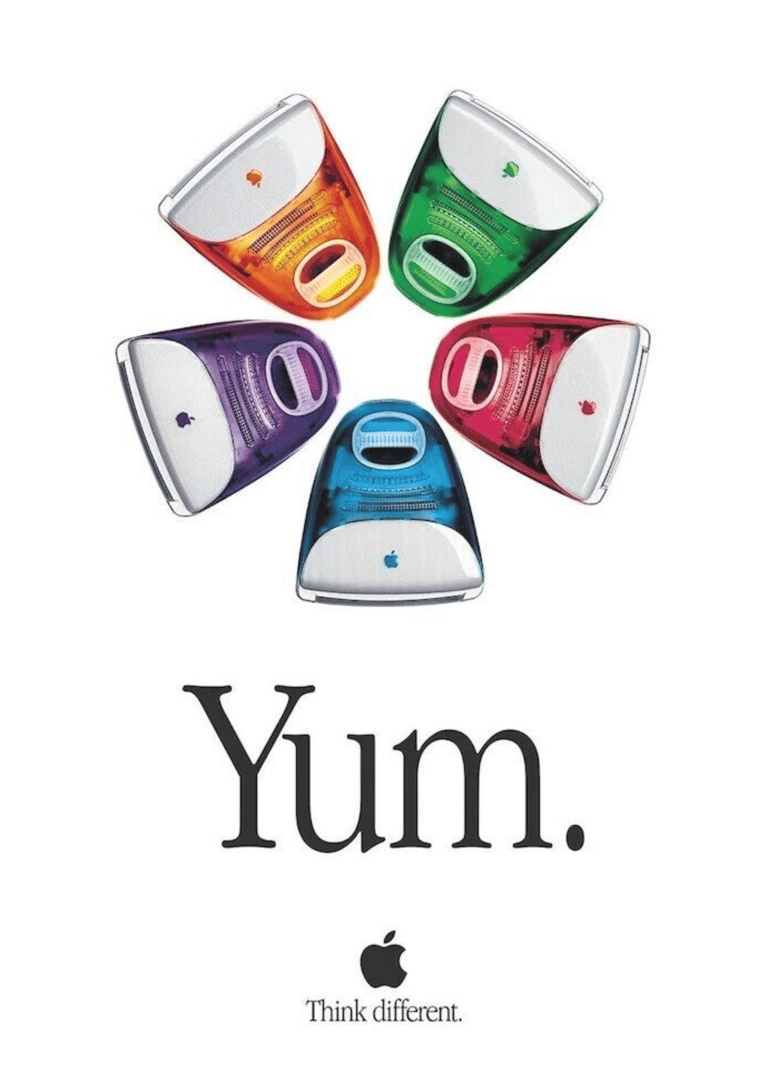Monochrome Minds: How Productivity Erased Creativity
We live in a world that glorifies speed, efficiency, and conformity, but what have we sacrificed along the way? From the candy-coloured iMacs of the 90s to the monotony of monochrome, our culture’s obsession with fast living is erasing the beauty and creativity that once defined us.
6/9/20257 min read


I find myself often thinking about the pace of life we’ve all grown accustomed to. It’s not just about how quickly things happen now, but how little we seem to pause and question whether this speed is serving us. Everything is designed to move faster, as if speed itself has become the only benchmark of success. The world operates like an assembly line, where efficiency is king, and anything that can’t keep up is swiftly replaced. There’s little room for the art of lingering, of truly savouring what’s in front of us. We’ve become a culture of fast food, not just in what we eat, but in how we consume nearly everything.
I still remember the day Facebook introduced the “message seen” function. It was subtle but impactful. It made me wonder: is there an underlying push to accelerate our interactions, to make us feel obligated to respond, to move on quickly so the next thing can take its turn? It’s as if technology is teaching us to treat every moment as disposable, every conversation as a transaction. Instead of pausing to think or reflect, we’re nudged to react and produce, then hurry along to the next task. And in that rush, something important is lost.
As someone who loves reading, I’ve felt this shift personally. Life, in its unrelenting demands, transformed me into a fast reader. Not the kind who absorbs every detail with impressive efficiency, but the kind who skims for progress’ sake, who measures success by how quickly the final page is turned. My mind, ever restless, struggles to focus, so I’ve turned to audiobooks to help. At first, it felt like a perfect solution, listening as I read helped me stay on track. But over time, I began to increase the playback speed, first just a little, then more, until the words flew by in a blur. It became about finishing rather than experiencing, about ticking off a box rather than lingering in the richness of the text.
This habit extends beyond reading. The fast food culture we’ve embraced trains our minds to crave constant stimulation, to equate a slower pace with boredom. And boredom, in today’s world, is treated like a negative experience. Yet I can’t help but wonder if we’ve misunderstood boredom altogether. What if boredom isn’t an enemy to be vanquished but a space to be explored? In those unfilled moments, creativity often takes root. But we rarely allow ourselves to linger there, to let our thoughts wander without a goal or a timeline. We’ve been conditioned to move, to produce, to fill every gap with activity. Stillness feels like a luxury we can’t afford.
And so, we’ve become tools of the machine. We drive production lines forward, not just in factories but in every corner of our lives. The rhythm of modern life dictates that we’re always pushing, always achieving, always on to the next thing. The result? A profound disconnection from ourselves and from the world around us. We’re losing the ability to slow down, to immerse ourselves in what truly matters, to find meaning in the spaces between.
It’s a strange paradox. We have more tools than ever to make life easier, yet those tools seem to trap us in a cycle of constant acceleration. We’re overwhelmed by choice, by information, by demands on our time and attention. And in that overwhelm, we’ve forgotten how to breathe. We’ve forgotten the beauty of doing one thing at a time, of giving our full attention to a single task, a single conversation, a single moment.
Do you see how this may, or has been, shaping our minds? We’re becoming accustomed to shallow engagement, to skimming the surface rather than diving deep. Social media reinforces this with its endless scroll, its snippets of information designed to grab our attention for a fleeting moment before we’re lured to the next post. Even our relationships are affected. We’re so used to quick replies, instant gratification, and surface-level interactions that we’ve forgotten the art of truly connecting, of sitting with someone’s words and letting them sink in before we respond.
The implications of this go beyond personal habits. When we lose the ability to slow down, we also lose the ability to think critically, to question, to create. Innovation requires space, not just physical space but mental and emotional space. It requires time to sit with an idea, to let it evolve, to follow it down unexpected paths. But in a world that prioritises speed, there’s little room for such luxuries. We’re pressured to produce results quickly, to meet deadlines, to prove our worth by how much we can accomplish in a day. Even Steve Jobs once said, although with a different intention but seems fitting, that “You can't just ask customers what they want and then try to give that to them. By the time you get it built, they'll want something new.”
And so, we trade depth for efficiency. We trade meaning for productivity. We trade joy for progress. It’s a costly bargain, one that leaves us feeling empty even as we achieve more than ever before. Because true fulfilment doesn’t come from how much we produce. It comes from how deeply we engage, how fully we live, how present we are in the moments that matter.
The fast food culture not only erodes our ability to savour and appreciate life but also dulls the vibrancy of our surroundings. This shift isn’t just metaphorical; I’m talking about a literal fading of colour. Have you ever noticed the difference in the aesthetics of the past compared to now? Watch an episode of a sitcom from the 1980s or 1990s, something like Growing Pains or even Friends. Take a moment to absorb the colours on the sets, the lively tones in the furniture, the bold patterns in the upholstery, and even the hues of the cars parked outside. There was a certain exuberance to it all, an unspoken celebration of diversity in colour. You can notice the production team’s effort to recreate the same vibrance in a more modern shown Young Sheldon.
Now, look around today. How many different car colours do you see when you step outside? Shades of grey, black, white, and the occasional blue dominate the streets, as if the palette has been reduced to the most neutral, the most unassuming tones. The variety, the personality that colours once offered, seems to have been stripped away. It’s as though society has collectively decided that standing out is too much, that blending in is safer. Colourful cars are now mostly associated with a company brand, like Royal Mail’s bright red vans or the vivid yellow of DHL delivery vehicles, designed to grab attention and stand out on the road. Who would then want a car in the same eye-catching colour, knowing it might make them feel like they were driving a company car rather than something uniquely their own?
This shift towards a less colourful world isn’t just about preference. It’s indicative of a deeper societal trend. Take the iconic moment when Steve Jobs reintroduced Apple to the world with the iMac line. It was an intentional departure from the dull, familiar beige that dominated computers at the time, a deliberate effort to shake things up and inject personality into technology. The colours he chose were bright, bold, and unapologetically joyful. The marketing even reflected this, with the word “Yum” plastered across posters. It was a statement, a celebration of individuality, a reminder that technology didn’t have to be dull or utilitarian. They could be something vibrant, fun, and accessible. They defied the monotony and hinted at a world where creativity wasn’t just welcomed but celebrated. Yet, even Apple has shifted back to monochrome, as if to say that fun and creativity are luxuries we can no longer afford. I suspect that this was not the vision Apple intended. They tried bringing back the colourful iPhone 5c in 2013, but the sales faltered. Perhaps society has been quietly trained to equate bright colours with a lack of so-called "professionalism," whatever that term is supposed to imply. Consider this, if colours represent the vibrancy, fun, accessibility, creativity and boldness in life, then what have we really been asked to abandon?
Buildings, too, have followed this trend. Modern architecture often favours sharp edges and sterile designs, with glass and concrete dominating skylines. Furniture trends lean towards minimalism, where the most popular colour seems to be white or grey. The world around us is becoming a series of boxes, rectangles with no texture, no playfulness, no life. Walk into an Ikea showroom, and you’ll see what I mean. It’s all clean lines and subdued tones, a reflection of a culture that values efficiency over expression.
What’s most concerning is what this says about our collective mindset. By removing colour, variety, and texture, we’re also removing the permission to be creative, to be different, to step outside the lines. We’re being gently nudged into conformity, into a factory style existence where individuality is smoothed out and replaced with uniformity. We’re told that the square is the ideal shape, that deviation is messy, that simplicity is supreme. And while simplicity has its place, it should not come at the cost of joy, of spontaneity, of the vibrant messiness that makes life worth living.
Colour is more than just decoration, it’s a language. It communicates emotions, ideas, and identities. When we allow our world to become monochrome, we’re not just losing aesthetics, we’re losing a part of our humanity. The beige and grey of our surroundings reflect the beige and grey of our lives, lives stripped of the richness that comes from diversity and expression.
I brought up Steve Jobs earlier, so it feels fitting to close with one of his most well-known quotes:
“Here’s to the crazy ones.
The misfits.
The rebels.
The troublemakers.
The round pegs in the square holes.
The ones who see things differently.
They’re not fond of rules.
And they have no respect for the status quo.
You can praise them, disagree with them, quote them, disbelieve them, glorify or vilify them.
About the only thing you can’t do is ignore them.
Because they change things.
They invent. They imagine. They heal.
They explore. They create. They inspire.
They push the human race forward.
Maybe they have to be crazy.
How else can you stare at an empty canvas and see a work of art?
Or sit in silence and hear a song that’s never been written?
Or gaze at a red planet and see a laboratory on wheels?
We make tools for these kinds of people.
While some see them as the crazy ones, we see genius.
Because the people who are crazy enough to think they can change the world, are the ones who do.”
